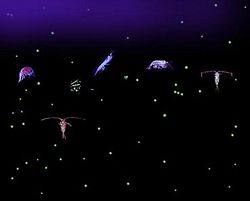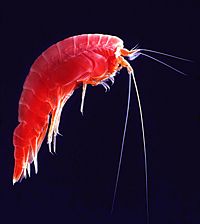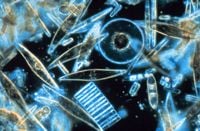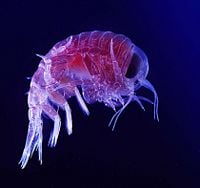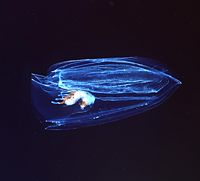Difference between revisions of "Plankton" - New World Encyclopedia
({{Contracted}}) |
|||
| Line 1: | Line 1: | ||
'''Steve, I added the articles from phytoplankton and bacterioplankton from Wikipedia. This is because in other articles, we often cite phytoplankton and zooplankton, and if they are a separate section, I can link right to those sections. But there was not any Wikipedia article on zooplankton, so please author a paragraph on them in the relevant section. Because I simply cut and pasted from the phytoplankton and bacterioplankton articles, there may be some overlap with what is already in the article. Thanks.''' [[User:Rick Swarts|Rick Swarts]] 21:41, 30 May 2006 (UTC) | '''Steve, I added the articles from phytoplankton and bacterioplankton from Wikipedia. This is because in other articles, we often cite phytoplankton and zooplankton, and if they are a separate section, I can link right to those sections. But there was not any Wikipedia article on zooplankton, so please author a paragraph on them in the relevant section. Because I simply cut and pasted from the phytoplankton and bacterioplankton articles, there may be some overlap with what is already in the article. Thanks.''' [[User:Rick Swarts|Rick Swarts]] 21:41, 30 May 2006 (UTC) | ||
| − | + | {{Contracted}} | |
Revision as of 16:34, 12 June 2006
Steve, I added the articles from phytoplankton and bacterioplankton from Wikipedia. This is because in other articles, we often cite phytoplankton and zooplankton, and if they are a separate section, I can link right to those sections. But there was not any Wikipedia article on zooplankton, so please author a paragraph on them in the relevant section. Because I simply cut and pasted from the phytoplankton and bacterioplankton articles, there may be some overlap with what is already in the article. Thanks. Rick Swarts 21:41, 30 May 2006 (UTC)
Plankton is the collective name for certain organisms (mostly microscopic) which drift in the water of the oceans, lakes, and other bodies of water. Plankton have a tremendous importance in the web of life on earth.
Definitions
The name plankton is derived from the Greek word planktos, meaning "wanderer" or "drifter". While some forms of plankton can swim, they can not do so strongly enough to avoid being carried along by the water current. This is in contrast to nekton organisms that can swim against the current and control their position (e.g. fish, squid, and marine mammals). It is also in contrast to benthos organisms which live on the bottom.
Within the plankton itself, holoplankton are those organisms that spend their entire life cycle as part of the plankton (e.g. most algae, copepods, salps, and jellyfish). By contrast, meroplankton are those organisms that are only planktonic for part of their lives, usually the larval stage (e.g. the larvae of sea urchins, starfish, crustaceans, marine worms, and most fish.
The study of plankton is termed planktology. Individual plankton are referred to as plankters.
Functional groups
Plankton are primarily divided into broad functional (or trophic level) groups:
- Phytoplankton (from Greek phyton, or plant), use photosynthesis to convert sunlight into chemical energy for life.
- Zooplankton (from Greek zoon, or animal), feed on the phytoplankton or other zooplankton.
- Bacterioplankton, mainly decompose the remains of other organisms.
This scheme divides the plankton community into broad producer, consumer and recycler groups. In reality, even the trophic level of some plankton is not straightforward. For example, although most dinoflagellates are either photosynthetic producers or heterotrophic consumers, many species do both depending upon their circumstances.
Phytoplankton
Most phytoplankton are too small to be individually seen with the unaided eye. However, when present in high numbers, their presence may appear as discoloration of the water (the color of which may vary with the phytoplankton present).
Phytoplankton, like plants, obtain energy through a process called photosynthesis, and so must live in the well-lit surface layer (termed the euphotic zone) of an ocean, sea, or lake. Through photosynthesis, phytoplankton (and terrestrial plants) are responsible for much of the oxygen present in the Earth's atmosphere. Their cumulative energy fixation in carbon compounds (primary production) is the basis for the vast majority of oceanic and some freshwater food chains (chemosynthesis is a notable exception). As a side note, one of the more remarkable food-chains in the ocean—remarkable because of the small number of links—is that of phytoplankton fed on by krill (a type of shrimp) fed on by baleen whales.
While almost all phytoplankton species are obligate photoautotrophs, there are some that are mixotrophic and other, non-pigmented species that are actually heterotrophic (the latter are often viewed as zooplankton). Of these, the best known are dinoflagellate genera such as Noctiluca and Dinophysis, that obtain organic carbon by ingesting other organisms or detrital material.
In terms of numbers, the most important groups of phytoplankton include the diatoms, cyanobacteria and dinoflagellates, although many other groups of algae are represented. One group, the coccolithophorids, is responsible (in part) for the release of significant amounts of dimethyl sulfide (DMS) into the atmosphere. DMS is converted to sulfate and these sulfate molecules act as cloud condensation nuclei, increasing general cloud cover.
Zooplankton
needs some elaboration
Bacterioplankton
Bacterioplankton refers to the bacterial component of the plankton that drifts in the water column. The name comes from the Greek term, πλαγκτον, meaning "wanderer" or "drifter", and bacterium, a word coined in the 19th century by Christian Gottfried Ehrenberg. They are found in both seawater and freshwater.
Most bacterioplankton (for instance, Bacillus and Nitrosomonas) obtain their energy through decomposition of other organisms, which largely renders them dependent on the phytoplankton for the production of dissolved organic matter as their main food source. A few species of bacterioplankton are capable of photosynthesis and chemosynthesis. Bacterio- and phytoplankton can regulate each others' numbers through mutual dependence and competition for resources such as phosphorus. They are preyed upon by protozoa and some cladocera, as well as phages.
Size groups
Plankton are also often described in terms of size. Usually the following divisions are used:
- Megaplankton, 2×10-1→2×100 m (20-200 cm)
- Macroplankton, 2×10-2→2×10-1 m (2-20 cm)
- Mesoplankton, 2×10-4→2×10-2 m (0.2 mm-2 cm)
- Microplankton, 2×10-5→2×10-4 m (20-200 µm)
- Nanoplankton, 2×10-6→2×10-5 m (2-20 µm)
- Picoplankton, 2×10-7→2×10-6 m (0.2-2 µm), mostly bacteria
- Femtoplankton, < 2×10-7 m, (< 0.2 µm), consisting of marine viruses
However, some of these terms may be used with very different boundaries, especially on the larger end of the scale. The existence and importance of nano- and even smaller plankton was only discovered during the 1980s, but they are thought to make up the largest proportion of all plankton in number and diversity.
Distribution
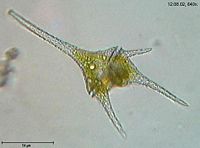
Plankton are found throughout the oceans, seas and lakes of Earth. However, the local abundance of plankton varies horizontally, vertically and seasonally. The primary source of this variability is the availability of light. All plankton ecosystems are driven by the input of solar energy (but see chemosynthesis), and this confines primary production to surface waters, and to geographical regions and seasons when light is abundant.
A secondary source of variability is that of nutrient availability. Although large areas of the tropical and sub-tropical oceans have abundant light, they experience relatively low primary production because of the poor availability of nutrients such as nitrate, phosphate and silicate. This is a product of large-scale ocean circulation and stratification of the water column. In such regions, primary production, still usually occurs at greater depth, although at a reduced level (because of reduced light).
Studies have shown[citation needed] that the mineral iron (but only in the proper amounts) leads to increased blooms of many (though not all) kinds of phytoplankton. Iron is primarily made available to oceanic phytoplankton through the deposition of atmospheric dust on the sea surface. Oceanic areas adjacent to arid parts of continents thus typically have abundant phytoplankton (e.g., the western Atlantic ocean, where trade winds bring dust from the Sahara Desert in north Africa). It seems a paradox that arid land areas may actually contribute to increased plant life proliferation in the world's oceans. It has been theorized (but never actually attempted) that large-scale 'seeding' of the world's oceans with iron would generate such massive blooms of phytoplankton so as to draw enough carbon dioxide out of the atmosphere to counteract the Greenhouse Effect (or global warming).[citation needed]
While plankton are found in the greatest abundance in surface waters, they occur throughout the water column. At depths where no primary production occurs, zooplankton and bacterioplankton instead make use of organic material sinking from the more productive surface waters above. This flux of sinking material can be especially high following the termination of spring blooms.
Biogeochemical significance
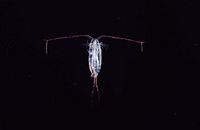
Aside from representing the bottom few levels of a food chain that leads up to commercially important fisheries, plankton ecosystems play a role in the biogeochemical cycles of many important elements. Of particular contemporary significance is their role in the ocean's carbon cycle.
As stated, phytoplankton fix carbon in sunlit surface waters via photosynthesis. Through (primarily) zooplankton grazing, this carbon enters the planktonic foodweb, where it is either respired to provide metabolic energy, or accumulates as biomass or detritus. As living or dead organic material is typically more dense than seawater it tends to sink, and in open ocean ecosystems away from the coasts this leads to the transport of carbon from surface waters to the deep. This process is known as the biological pump, and is one of the reasons that the oceans constitute the largest (active) pool of carbon on Earth.
Some researchers have even proposed that it might be possible to increase the ocean's uptake of carbon dioxide generated through human activities by increasing the production of plankton through fertilization, primarily with the micronutrient iron. However, it is debatable whether this technique is practical at a large scale, and some researchers have drawn attention to possible drawbacks such as ocean anoxia and resultant methanogenesis (caused by the excess production remineralising at depth).[citation needed]
ReferencesISBN links support NWE through referral fees
- Omori, M. and Ikeda, T. (1992). Methods in Marine Zooplankton Ecology, Krieger Publishing Company, Malabar, USA.
Credits
New World Encyclopedia writers and editors rewrote and completed the Wikipedia article in accordance with New World Encyclopedia standards. This article abides by terms of the Creative Commons CC-by-sa 3.0 License (CC-by-sa), which may be used and disseminated with proper attribution. Credit is due under the terms of this license that can reference both the New World Encyclopedia contributors and the selfless volunteer contributors of the Wikimedia Foundation. To cite this article click here for a list of acceptable citing formats.The history of earlier contributions by wikipedians is accessible to researchers here:
The history of this article since it was imported to New World Encyclopedia:
Note: Some restrictions may apply to use of individual images which are separately licensed.
